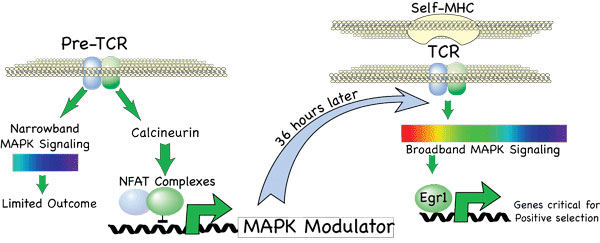

Lab Interest: Lymphocyte Development
Mechanism of Converting Graded Signals to Discret Outcomes during Lymphocyte Development
A general problem in signal transduction and transcription is the mechanism by which signals of different intensities are converted to different cell fates. For example, morphogens produce different types of cells along a gradient of morphogenic concentrations at different distances from the site of secretion. In the development of the immune system high intensity signals are translated into cell death and the elimination of clones of cells bearing T cell receptors that interact with abundant self antigens. On the other hand weak signals generated by a satisfactory match between MHC and T cell receptor lead to the positive selection of T cells able to react to foreign antigen. The absence of a signal, resulting from a failure to correctly rearrange the antigen receptor genes or MHC mismatch leads to cell death by neglect. How signals of different intensity are converted to discret cell fates is not known for any of these systems. Our laboratory has been focusing on the development of T lymphocytes to try to understand this general problem in signaling and transcription.
The competence to respond to a graded signal is determined by prior signaling by calcineurin and NFAT. Elena Gallo, Joel Neilson and Monte Winslow in our laboratory found that the ability of T lymphocytes to be positvely selected required early signaling by calcineurin. In mice lacking calcineurin, the T cell receptor produced only narrow range signals and postive selection of lymphocytes was lost. Remarkably they found that calcineurin was needed to produce a window of Erk hypersensitivity that was essential for positive selection of T cells. Furthermore, Elena Gallo and Wen-Qi showed that calcineurin functioned by controlling the production of a raf inhibitor and that mice expressing hypersensitive alleles of either Erk or Raf could overcome the defect in calcineurin null mice. Their studies indicate that calcineurin is needed to transcribe some unknown regulator that controls Erk signaling by regulating Raf. Presently Wen-Qi Ho and Amy Radamacker are searching for this mysterious Mapk Modulator as illustrated below. We hope that these studies will lead to an understanding of a general development problem and also provide new targets for development of more selective and safe immunosuppressants.
Calcineurin and NFAT Set the Signaling Bandwidth Essential for Positive Selection

